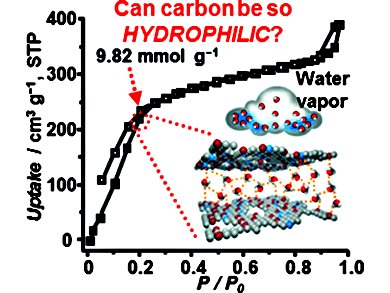Atmospheric water capture (AWC) from air has significant applications in view of increasing water shortages and for clean energy sources. The effectiveness of AWC technologies has been limited by poor durability of desiccant materials and high energy costs for their recovery. The application of porous carbons to AWC has been hampered because of their intrinsic hydrophobicity and wide micropore size distribution.
Stefan Kaskel and colleagues at Technische Universität Dresden, Germany, have synthesized a class of porous carbon cuboids with ultra-hydrophilic properties, which exhibited the highest atmospheric water capture performance for porous carbons to date, 9.82 mmol g−1 at P/P0 = 0.2 and 25 °C. The porous carbons displayed remarkable durability and chemical and thermal stability, maintaining their record status for water capture capacity even after pyrolysis at 1000 °C or immersion in 4 M HCl.
Detailed microscopic, physisorption, kinetics, and spectroscopic investigations revealed that maximization of the synergistic effects between surface heterogeneity and micropore architecture was responsible for the high performance of these materials.
- Unusual Ultra-Hydrophilic, Porous Carbon Cuboids for Atmospheric-Water Capture,
Guang-Ping Hao, Giovanni Mondin, Zhikun Zheng, Tim Biemelt, Stefan Klosz, René Schubel, Alexander Eychmüller, and Stefan Kaskel,
Angew. Chem. Int. Ed. 2015, 54.
DOI: 10.1002/anie.201409439
 The highest atmospheric water capture capacity for a porous carbon (9.82 mmol g−1 at P/P0 = 0.2 and 25 °C) to date was reported for ultra-hydrophilic porous carbon cuboids.
The highest atmospheric water capture capacity for a porous carbon (9.82 mmol g−1 at P/P0 = 0.2 and 25 °C) to date was reported for ultra-hydrophilic porous carbon cuboids.
Find more world records from all branches of chemistry on the Records and Challenges platform of The Chemical Record.




